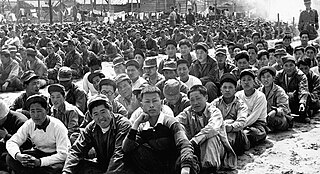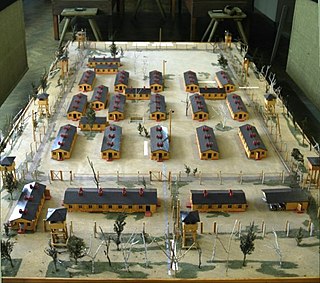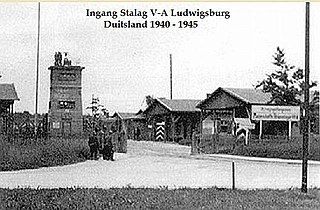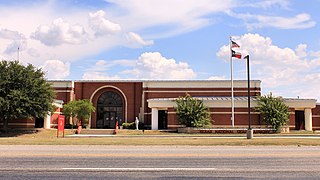
Aliceville is a city in Pickens County, Alabama, United States, located thirty-six miles west of Tuscaloosa. At the 2010 census its population was 2,486, down from 2,567 in 2000. Founded in the first decade of the 20th century and incorporated in 1907, the city has become notable for its World War II-era prisoner-of-war camp, Camp Aliceville. Since 1930, it has been the largest municipality in Pickens County.

The Afrika Korps or German Africa Corps was the German expeditionary force in Africa during the North African campaign of World War II. First sent as a holding force to shore up the Italian defense of its African colonies, the formation fought on in Africa, under various appellations, from March 1941 until its surrender in May 1943. The unit's best known commander was Field Marshal Erwin Rommel.

A prisoner-of-war camp is a site for the containment of enemy fighters captured by a belligerent power in time of war.
Marlag und Milag Nord was a Second World War German prisoner-of-war camp complex for men of the British and Canadian Merchant Navy and Royal Navy. It was located around the village of Westertimke, about 30 km (19 mi) north-east of Bremen, though in some sources the camp's location is given as Tarmstedt, a larger village about 4 km (2.5 mi) to the west. There were also American merchant seamen detained here as well as some U.S. Navy personnel.

The Atlit detainee camp was a concentration camp established by the authorities of Mandatory Palestine in the late 1930s on what is now the Israeli coastal plain, 20 kilometres (12 mi) south of Haifa. Under British rule, it was primarily used to hold Jews and Arabs who were in administrative detention; it largely held Jewish immigrants who did not possess official entry permits. Tens of thousands of Jewish refugees were interned at the camp, which was surrounded by barbed wire and watchtowers.

Oflag VII-A Murnau was a German Army prisoner-of-war camp for Polish Army officers during World War II. It was located 2 km (1.2 mi) north of the Bavarian town of Murnau am Staffelsee.
Stalag XX-B was a German prisoner-of-war camp in World War II, operated in Wielbark. It housed Polish, British, French, Belgian, Serbian, Soviet, Italian, Australian, New Zealand and Canadian POWs.

In Germany, stalag was a term used for prisoner-of-war camps. Stalag is a contraction of "Stammlager", itself short for Kriegsgefangenen-Mannschaftsstammlager, a literal translation of which is "War-prisoner" "enlisted" "main camp". Therefore, technically "stalag" simply means "main camp".

Stalag VIII-C was a German World War II prisoner-of-war camp, near Sagan, Lower Silesia. It was adjacent to the famous Stalag Luft III, and was built at the beginning of World War II, occupying 48 ha. It housed Allied POWs of various nationalities, incl. Polish, French, Belgian, British, Canadian, Greek, Yugoslav, Soviet, Australian, New Zealand, South African, Italian, Senegalese, Algerian, Moroccan and Slovak.
Oflag VII-B was a World War II German prisoner-of-war camp for officers (Offizierlager), located in Eichstätt, Bavaria, about 100 km (62 mi) north of Munich.
Oflag X-B was a World War II German prisoner-of-war camp for officers (Offizierlager) located in Nienburg/Weser, Lower Saxony, in north-western Germany. Adjacent to it was the enlisted men's camp (Stammlager) Stalag X-C.

Stalag V-A was a German World War II prisoner-of-war camp (Stammlager) located on the southern outskirts of Ludwigsburg, Germany. It housed Allied POWs of various nationalities, including Poles, Belgians, Dutchmen, Frenchmen, Britons, Soviets, Italians and Americans.

Camp Bowie is a United States National Guard training center located in west-central Texas on the southern outskirts of Brownwood.
Stephen Fleck was a professor in the psychiatry, epidemiology and public health departments at the Yale University School of Medicine from 1953 to 1983 and professor emeritus from 1983 until his death.

Members of the German military were interned as prisoners of war in the United States during World War I and World War II. In all, 425,000 German prisoners lived in 700 camps throughout the United States during World War II.
Whitewater was a labour camp for German prisoners-of-war in Riding Mountain National Park, Manitoba. Operating from 1943 to 1945, the camp was built on the northeast shore of Whitewater Lake, approximately 300 kilometres (190 mi) north-west of Winnipeg. The camp consisted of fifteen buildings and housed 440 to 450 prisoners of war.
Camp Aliceville was a World War II era prisoner of war (POW) camp in Aliceville, Alabama. Its construction began in August 1942, it received its first prisoners in June 1943, and it shut down in September 1945. It was the largest World War II POW camp in the Southeastern United States, holding between 2,000 and 12,000 German prisoners at any one time.

Stalag 383 was a German World War II Prisoner of War camp located in Hohenfels, Bavaria.










